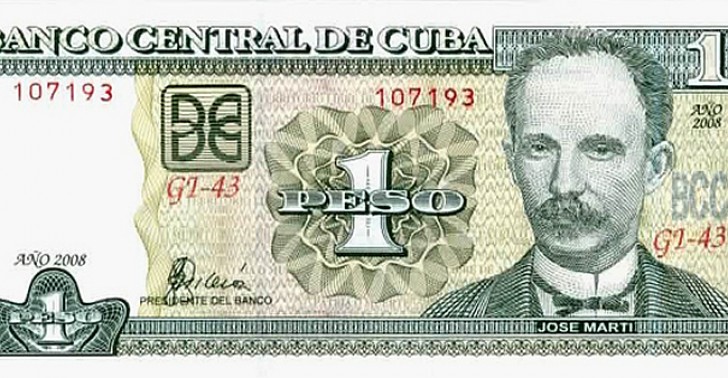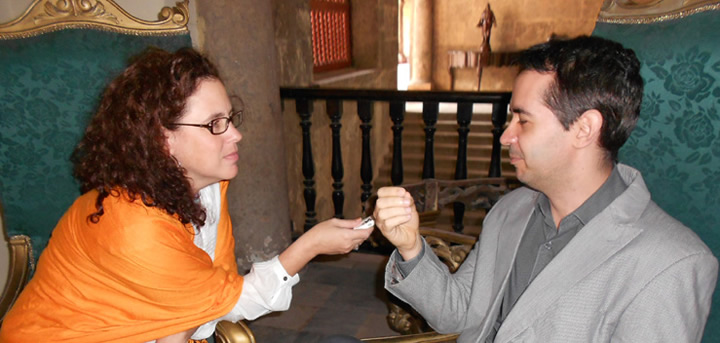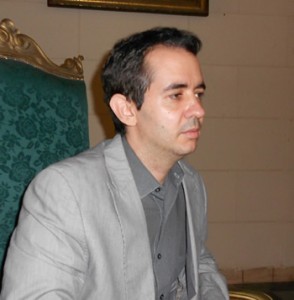
Vidal: The CUC will vanish ‘quite swiftly’
HAVANA – One day — so far unknown but probably closer than imagined — will be “Day Zero” for the start of the process of monetary unification foretold in 2011 by the Guidelines for the economic policy of the Cuban government.
A complex Resolution, No. 19 of 2014 from the Ministry of Finances and Prices, published in the Official Gazette, brings the “news” on the same day that economist Pavel Vidal participates in the event “Religious Faith, National Institutionality and Social Models” organized in Havana by the magazine Lay Space (Espacio Laical).
Resolution No. 19 describes the financial and physical measures that will become effective on the eve of monetary unification and describes the procedures and standards for the revaluation of the Cuban peso in state agencies.
Before appearing at the conference, Vidal made himself available to “decode” the document (which, to most Cubans, is unintelligible) and visualize the consequences of this transcendental step in the process of reform in Cuba. The translator’s clarifications here [are in brackets.]
Pavel Vidal: From what I understand, there is an intention, typical of all reforms, to try to imagine things from above, to try to figure them out before they happen, and that’s bureaucratic, very bureaucratic. That’s how all regulations are, particularly those about fiscal policy; this is not so much monetary as it is fiscal and price-related.
They [the authorities] are regulating everything that will happen right after the Cuban peso is devalued in business circles. That’s what they call Day Zero. They are preparing for that. After the devaluation, there will several effects in the business world, in terms of the appraisement of inventories, of all the assets and debts. Everything that’s valued in CUC [convertible pesos] and must be expressed in Cuban pesos will be multiplied by an exchange rate that they haven’t specified. That’s why [the process] is fiscal, rather than monetary.
When you apply devaluation to a business (and obviously this will be a significant devaluation, because the experiments told of a 1-to-10 rate, that’s a devaluation of 900 percent) you’ll have many effects, above all inflationary — effects on wages and on the balance sheets of businesses. This Regulation will control all those effects.
What I can’t perceive is how far they’re nullifying the effects or how far they’re cushioning them. It would be better if they cushioned them, not nullify them. If they nullify them, we’re talking about a nominal devaluation. If they cushion them, we’re talking about a real devaluation.
But the Resolution is so bureaucratic and contains so many formulas for price mechanisms, for wage scales, that we have to study it with great care. In it, the authorities are regulating the appraisement of assets, liabilities, wholesale prices; they’re regulating the effects inside the businesses. But they’re also regulating retail prices and wages, which are the ways whereby monetary unification affects the population, which is not through the CADECAs’ exchange rate.
Milena Recio: How can the people read this Resolution, this moment, this step that indicates that unification is actually going ahead?
PV: One has to study that in detail: the effects on retail prices and wages. I have the impression — what happens is that I don’t want to make a statement of that kind, that they’re not nullifying the effects and that there will be effects on the retail prices and wages.
MR: What are you referring to, exactly? What kind of effects can there be?
PV: Increases in both retail prices and wages.
MR: But President Raúl said a few days ago during the CTC [labor federation] congress that there won’t be any wage changes. “To institute an across-the-board increase of salaries would be irresponsible and would have counterproductive effects,” he said.
PV: There will be no across-the-board wage increase, though there may be increases in some sectors. It is very important that the businesses that benefit from the devaluation be able to raise wages, because the initial effects post-devaluation are cost-related. The benefits come later and the benefits depend on the response from the state enterprise, whether it produces more or exports more, once it is in a better financial situation.
MR: Has Cuba sufficiently planned a decentralized wage policy? In other words, are there any regulatory mechanisms that cover wage decisions made by local or specific businesses?
PV: Everything is regulated by the Plan. The Plan authorizes the wages. But it contains a formula that I still haven’t figured out. In fact, I was told that several seminars would explain to the businessmen how to keep accounts on all that. But, from what I read, it seems to me that there will be effects on wages and on other statements that were made.
It has been said that devaluation could break the vicious circle linking low wages and low productivity. Wages don’t change because there’s no productivity, and productivity doesn’t change because wages are not raised. With devaluation, business can benefit, wages can be raised, workers have greater incentive, and production and productivity increase.
MR: How quickly do you think that will influence the macroeconomy and the microeconomy and domestic economy? How do you see this?

PV: From my reading [of Resolution No. 19], it seems that things will develop faster than expected. We academicians always talked about a unification of the rates of exchange followed by a unification of the currency. But, what the Resolution tells me is that the process is reversed, because [the authorities] are talking about Day Zero, and on Day Zero the CUC disappears, and everything is expressed in [national] pesos. That’s monetary unification.
MR: Will the the CUC disappear only in terms of accounting or will it happen simultaneously in terms of circulation? Does Day Zero envision the extinction of the CUC in terms of circulation?
PV: What I understood there was that the CUC will become extinct in business, as happened to businesses in 2003, when the economy was unlinked from the dollar. The Resolution [No. 19] says that CUCs will be sold to the state, to the Central Bank, in exchange for Cuban pesos. That’s what happened with the dollars.
Normally, economic policies lean on prior experiences. So, it’s not illogical to think that, in a few weeks, all business companies will sell their CUCs to the Central Bank in exchange for Cuban pesos.
What is not clear to me is how far this will involve the population. In 2003 and 2004, businesses went first and the population went the following year. But this Resolution does not deal explicitly with that.
MR: All these modifications have a timetable for development.
![Vidal: "The Resolution [No. 19] says that CUCs will be sold to the state, to the Central Bank, in exchange for Cuban pesos."](https://progresoweekly.us/wp-content/uploads/2014/03/Pavel_Vidal-300x300.jpg)
But, from what I see, the CUC’s disappearance will be quite swift, for businesses this year, for the population I don’t know when. But that creates too much uncertainty. There’s got to be a process whereby the two currencies [CUC and CUP] coexist as a means of savings, to make bank deposits.
MR: Here’s the question everybody is asking right now: If someone has saved CUCs, what should he do with them?
PV: It has been said — and it was done in 2003 and 2004 — that nobody loses with monetary reform. Those are savings accounts. If that is so, well, keep them diversified. That’s always the best option, a basket of coins.
MR: What is the relationship between this process of monetary and domestic-financial organization and the expectations of foreign investment that the Cuban authorities might have, or the potential investors who look at the Cuban economy from abroad, waiting for movement?
PV: Foreign investors basically work with dollars. When the CUC disappears, they won’t be directly affected. But there are benefits to foreign investors and to everyone in an economy that has a single currency and a rate of exchange that is closest to the rate of balance.
In other words, medium-term, everyone wins — the population, the state businesses, the foreign investors — because we emerge from the present situation of distortion: two currencies, two rates of exchange that generate a million inefficiencies.
Foreign investors today are isolated from the economy in Cuban pesos. The Cuban peso [CUP] does not appeal to them because it is not convertible. Once the entire economy functions in Cuban pesos and the Cuban peso becomes convertible, many sectors that today do not appeal to the foreign investor because of the monetary restrictions would become potential sectors of interes to that investor, i.e., telephony to Cubans, transportation, agriculture, the entire economy becomes potentially of interest to the foreign investor.
Besides, foreign businesses are interested in linking up with the [Cuban] economy but the existence of two currencies makes that very difficult. With a single currency, they can better link up with the national economy, reduce costs and thereby secure better benefits.

MR: What are the risks in this operation? What could happen to foil this process of unification?
PV: This process has costs and benefits.
MR: What would the costs be?
PV: The costs are the inflation and the balance sheets of the businesses. Some businesses will have to shut down. That’s a cost, but it’s necessary. There is more transparency and you can wee who is profitable and who is not profitable, who is efficient and who isn’t, and whoever is not efficient needs to be removed from the game. What’s important is that the inflationary costs come all at once, i.e., that an inflationary spiral does not develop, that any inflationary spiral be controlled.
But, because it’s good that some businesses shut down, it is also good that a little bit of inflation remains, because the prices need an adjustment. What’s important is that all that be controlled, that it doesn’t get out of hand, which is what [the authorities] in the Finance Ministry are trying to do with this Regulation.
What’s most relevant is that the benefits exceed the costs, and the benefits depend on the reaction of the state enterprise, on how effectively they provide a productive response to devaluation in a period of two to three years.
After four or five years, when the entire economy functions in Cuban pesos, there will be many benefits. You have a more realistic rate of exchange, a single currency, in other words, all those are benefits that imply a responsibility, because everything that is monetary and fiscal policy, everything that backs up the Cuban peso is fundamental. [It needs] transparency and rules, such as the rule for the emission [printing] of Cuban pesos.
One upcoming process is very important. This year, 30 percent of the fiscal deficit is being financed with currency emission. Changes should be made to finance 100 percent [of the deficit] with public-debt financing, without currency emission.
MR: Because the emission weighs on inflation.
PV: Exactly. They are needful mechanisms. They must consolidate gradually, so that, in three years, everything may function totally in Cuban pesos and the Cuban peso becomes a credible unit of currency. Because the benefits for the foreign investor depend on a credible, convertible Cuban peso, on rules, transparency, statistics.
MR: Within that scenario, when will the Cuban economy take off? We know that this year and the next will be difficult.
PV: That will be difficult. We have two years in which to get a productive response from the exporters. We have to help the exporters; we have to give them credit. Maybe some companies are initially affected but have potential for the future. We can give them a subsidy. In other words, intervention by the state is also needed.
MR: In other words, what this measure will produce is a major reorganization in business.
PV: Initially, it’s a shock. Then, later comes the reaction and we hope it will be a positive reaction, if the right conditions are created. That is why even the economists at the World Bank agreed with the economists at the University of Havana that a monetary reform must be accompanied by a structural reform of the state [business] enterprise.
The fact is that the benefits depend on the state enterprise. It needs to have the conditions to react. And there’s always many doubts there, because, when it comes to the state enterprise, there’s always many doubts.
MR: We have been talking all along about the state enterprise. But for more than a year, the sector of self-employed workers has not grown. Their number stays at approximately 450,000.
These new financial and monetary conditions that you are imagining, could they give a positive boost to the self-employed sector?
PV: Labor reform must go on. The state enterprise needs to be efficient. To be efficient, it needs to reduce the number of employees. Too big a labor force for so few economic results is not sustainable. So, it has to divert the flow of employees from the state sector to the non-state [private] sector.
But, as you say, [self-employment] is reaching a plateau, apparently at half a million. With the current regulations, that’s the plateau. In other words, the new licenses no longer make up for the licenses that are returned. The birth and mortality rates remain the same. We’re reaching a limit. Additional flexibility might be hoped for.
MR: In that sector.
PV: Yes. It has nothing to do with the dual currency.
MR: But it’s part of the package of things needed. That, plus foreign investment.
PV: That too. The Law on Foreign Investment should be applied not only to the big projects but also to the PYMES [small and medium businesses]. What I was going to say is what everybody says: open the way for the professionals. That’s the main contradiction one sees in the Cuban reform.
When you look at a future Cuba with optimism, you think of its human capital. That’s our main asset. And today, the reform that is advancing the quickest, the spaces of liberalization, is not directed at the professionals.
MR: Are you optimistic or pessimistic?
PV: That depends. If you look backward, you have reason to be optimistic. Cuba has changed a lot in the past six years. There is a slow but systematic and structural reform. There are many changes, i.e., the wholesale farm market, the size of the private sector — there are many things that are quite structural.
On the pessimistic side, there have been no significant results. So, all this, including its emergence, is not only a process of economic change but also of institutional change, with resistance to change.
I think that the only way to defeat the resistance to change is with results. As an economist, I see that the reform is structural, systematic, but the people are not interested in that. What they want is results, and they don’t see them. That’s the main reason for pessimism: no results are seen.
The goal for the reform was a growth rate [in the Gross Domestic Product] of 4.4 percent, and it barely reaches a 2.7 percent, on the average. This year, it’s even lower. And the projections show that those rates of growth are no longer reachable. The year 2016 will end with [a GDP increase] below the official goal.
Then we’d have to rethink if the way that the reform has been moving is the best or not. It’s no use saying that [the authorities] speed up the changes, because they have said many times that they’re not to give in on that. But we continue to insist that a reform can be managed at two speeds, the state enterprise being the slower.
According to international experience, if you apply shock to the state enterprise, it melts. But the small businesses, the farmers, the self-employed entrepreneur should not fear a Big-Bang-type liberalization, and that gives us more credibility, sends a clearer message. Two speeds CAN be managed, but, well —
I think that there is much resistance to change. [The authorities] know that the expansion of the private sector generates much resistance and are trying to overcome that resistance by acting drop by drop, a little at a time. What happens is, drop-by-drop reform produces no results.

